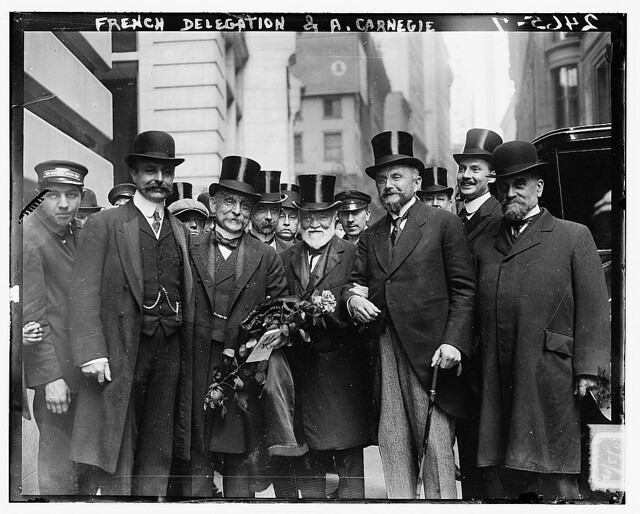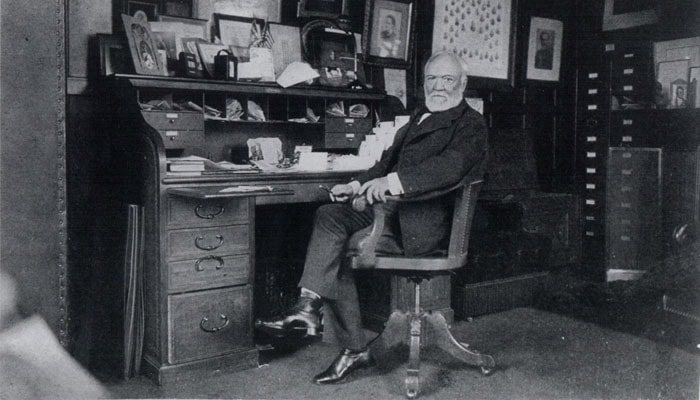Dear students,
Yesterday we read the story of Andrew Carnegie. Here is some more information about him. I tried to put everything interesting I could find on the internet about this man.
Yesterday we read the story of Andrew Carnegie. Here is some more information about him. I tried to put everything interesting I could find on the internet about this man.
I hope this information will help you learn more about the one of the richest people of the world of his time, a captain of steel industry and philanthropist, Andrew Carnegie. I hope you enjoy videos and old pictures.
After you finish reading this post, please, write a brief story about Andrew Carnegie and post it in your blogs. Those who don't have blogs can write their stories as comments after this post. Don't forget to write your name after the story.
After you finish reading this post, please, write a brief story about Andrew Carnegie and post it in your blogs. Those who don't have blogs can write their stories as comments after this post. Don't forget to write your name after the story.
Irena,
Here is a very short presentation about Carnegie. Please, watch it.
(Carnegie's birthplace)
The Carnegie family shared the top floor of this cottage with another family.
Andrew Carnegie, the son of a hand-loom weaver, was born in Scotland, on 25th November, 1835. The family had a long radical tradition and his father, William Carnegie, was an active Chartist.
Chartism was a movement for political and social reform in the United Kingdom during the mid-19th century, between 1838 and 1850. Chartism was possibly the first mass working class labor movement in the world.
The economic depression of 1848 convinced the Carnegie family to emigrate to the United States where they joined a Scottish colony at Allegheny near Pittsburgh. Andrew began work at 14 in a local cotton factory, but continued his education by attending night school.
Chartism was a movement for political and social reform in the United Kingdom during the mid-19th century, between 1838 and 1850. Chartism was possibly the first mass working class labor movement in the world.
The economic depression of 1848 convinced the Carnegie family to emigrate to the United States where they joined a Scottish colony at Allegheny near Pittsburgh. Andrew began work at 14 in a local cotton factory, but continued his education by attending night school.

Later Carnegie became a messenger boy in the local Pittsburgh Telegraph Office. His abilities were noticed by Thomas A. Scott, the superintendent of the western division of the Pennsylvania Railroad. He made Carnegie his secretary. During the Civil War Scott was appointed assistant secretary of war, and he went to Washington to work as his right-hand man. Carnegie's work included organizing the military telegraph system.
After the war Carnegie became a superintendent of the western division of the Pennsylvania Railroad. Carnegie invested in several promising ventures including the Wood Ruff Sleeping Car Company and several small iron mills and factories. The most important of these was Keystone Bridge, a company which he owned a one-fifth share.
Carnegie made regular visits to Britain, where he observed the rapid developments in the iron industry. Carnegie realized that steel would now replace iron for the manufacture of heavy goods.
In 1870 Carnegie erected his first blast furnace. Others followed and by 1874 he opened his steel furnace at Braddock. He took several partners, including Henry Flick.
Carnegie took a keen interest in social and political issues and wrote a series of books including Round the World (1881), An American Four-in-Hand in Britain (1883) and Triumphant Democracy (1886). He praised America's educational system.
(The king of industry and once the richest man in the world, Andrew Carnegie, visits Stoke Library in 1914.)
In June, 1889, the North American Review published a book by Carnegie on what he called the Gospel of Wealth. In the article Carnegie argued that it was the duty of rich men and women to use their wealth to benefit the welfare of the community. He wrote that a "man who dies rich dies disgraced".
In 1889 Carnegie decided to allow Henry Frick to become chairman of the Carnegie Company while he moved to New York to deal with the growing importance of research and development. Carnegie also spent six months of the year in Scotland with his family.
When Frick took control the firm consisted of various mills and furnaces in the Pittsburgh area, Frick was concerned that there was no centralized management structure and so in 1892 all productive units were integrated to form the Carnegie Steel Company. Valued at $25 million it was now the largest steel company in the world.

(Andrew Carnegie with members of a French delegation visiting the New York Chamber of Commerce including Baron deConstant, left of Carnegie)
The Carnegie Steel Company continued to expand and between 1889 and 1899 annual production of steel rose from 332,111 to 2,663,412 tons, and profits increased from $2 million to $40 million. There was growing conflict between Carnegie and Henry Flick during this period. This came to a head in 1899 and Carnegie bought out Frick for $15 million.
Carnegie set up a trust fund "for the improvement of mankind." This included the building of:
- 3,000 public libraries (380 in Britain)
- The Carnegie Institute of Pittsburgh
- The Carnegie Institute of Technology
- The Carnegie Institution of Washington for research into the natural and
physical sciences.
(Letter from Andrew Carnegie - April 26, 1898:
Andrew Carnegie Provides Grant of $210,000 to Build Andrew Carnegie Free Library Carnegie, Pennsylvania)
Carnegie also established the Endowment for International Peace in an effort to prevent future wars. He spent the last two decades of his life giving away the great bulk of his fortune. Major philanthropic ventures included the following:
- Carnegie Hall, a concert hall located in New York (1892)
- Carnegie Institution (1902) for research into American colleges and
universities
- Carnegie Hero Fund Commission (1904)
- Carnegie Endowment for the Advancement of Teaching (1905)
- Carnegie Endowment for International Peace (1910)
- Carnegie Corporation of New York (1911)
- Funding for the establishment of more than 2,800 libraries
- Major support for Tuskegee Institute
(Kingston Library)
Carnegie also was one of the first to call for a "league of nations" and he built a "a palace of peace" that would later evolve into the World Court. His hopes for a civilized world of peace were destroyed, though, with the onset of World War I in 1914. His wife said that with these hostilities his "heart was broken."

(Andrew Carnegie and Louise Carnegie, his wife)
By the time Andrew Carnegie died in August, 1919, he had given away $350,000,000. A further $125 million was placed with the Carnegie Corporation to carry on his good works.
This is the video about one of the libraries built by A. Carnegie.
Please, watch it.
Here is a link to an interesting site.
Kingston Museum was one hundred years old in 2004, and it celebrated throughout the year with a host of special events, activities and exhibitions.


(Kingston Library)
There is one more video about Carnegie's biography with some old pictures.
So, that is all about this interesting person.
"The average person puts only 25% of his energy and ability into his work.
The world takes off its hat to those who put in more than 50% of their capacity,
and stands on its head for those few and far between souls who devote 100%."





.jpg)


It is fine, nonetheless evaluate the information and facts around this correct. Andrew Chunis
ReplyDelete